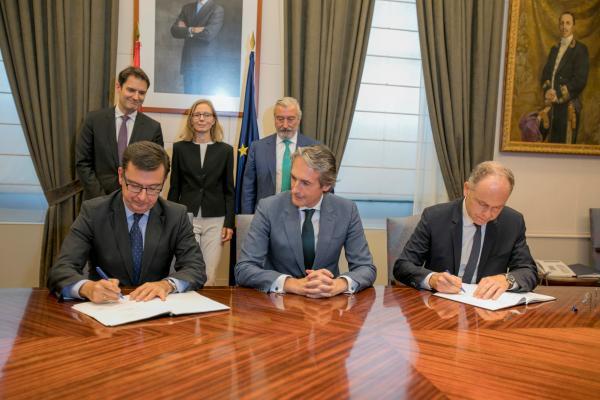
- This infrastructure will make it possible to improve connections between the Basque capitals, as well as links between Madrid and the Basque Country, and Spain and France
Minister of Public Works and Transport Íñigo de la Serna attended the signing of a EUR 600m loan granted by the European Investment Bank (EIB) to Adif Alta Velocidad. This loan is the first tranche of EUR 1.03bn in financing approved by the EIB on 19 September, and will be used to complete the project to build a high-speed rail line between the three Basque capitals (the “Y Vasca”).
The agreement was signed in Madrid by EIB Vice-President Román Escolano and Adif Alta Velocidad Chairman Juan Bravo.
The project – currently in its implementation phase – has received EIB financing from the outset with loans granted in 2012 and 2013 for a total of EUR 1.4bn.
These are some of the largest investments made by the Ministry of Public Works and Transport and the EIB to improve rail connections between the Basque capitals, between Madrid and the Basque Country and between Spain and France.
The project is also part of the Trans-European Transport Network (TEN-T), more specifically the so-called Atlantic Corridor connecting the Iberian Peninsula with Central Europe.
In practical terms, the financing signed today will make it possible to build 160 km of new high-speed rail line between Vitoria, Bilbao and San Sebastián, and to convert the conventional line between San Sebastián and the French border (around 17 km long) for mixed use (conventional and high-speed).
In addition, the project includes remodelling, adaptations and the provision of new access routes for high-speed rail at the Vitoria, Bilbao and San Sebastián train stations. The path of these new high-speed connections is complex, with 80 km of tunnels and 25 km of viaducts.
The new line has been designed for a speed of 250 km/h, cutting the travel time from Madrid to San Sebastián or Bilbao from the current five hours to around three and a half hours. When the Valladolid-Burgos-Vitoria section is completed, this will fall to two and a half hours.
As well as the travel time savings, the project will have a positive impact on the environment, as it will result in a reduction in road journeys and the associated emissions. More than 7 million people are expected to use these new high-speed lines in their first year of operation.
The project will also contribute to job creation, as almost 40 000 person-years of temporary employment are expected to be generated during the implementation phase and, once operational, the new high-speed lines will need 400 people to be employed for operations and maintenance.

Photographer: Mercedes Landete ©EIB
Download original